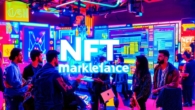
Is there a future for NFTs
Introduction
In recent years, non-fungible tokens (NFTs) have gained immense popularity among collectors, artists, and investors. These unique digital assets represent ownership of a specific item such as art, music, or sports memorabilia, offering an opportunity to own a piece of history. However, with the hype surrounding NFTs, there has been some debate about whether this market will continue to grow and flourish in the future.
The Current State of the NFT Market
According to a report by Grand View Research, the global NFT market size was valued at $448.2 million in 2020 and is expected to grow at a compound annual growth rate (CAGR) of 1,475.4% from 2021 to 2028. This growth is driven by increasing adoption among collectors, artists, and investors, as well as the potential for NFTs to revolutionize industries such as gaming and sports.
One of the most notable recent developments in the NFT market was the sale of the first-ever NFT art piece, “Everydays: The First 50 Days,” by digital artist Beeple for a record-breaking $69 million at Christie’s in March 2021. This sale not only set a new record for the most expensive NFT ever sold but also highlighted the growing interest and demand for these digital assets.
Another factor driving the growth of the NFT market is the increasing use of blockchain technology. Blockchain provides a secure and transparent platform for NFTs to be bought, sold, and stored, making it an attractive option for investors and collectors alike. In addition, the integration of NFTs into popular gaming and sports platforms such as NBA Top Shot and Cryptokitties has further boosted their popularity and adoption.
Exploring the Potential of NFTs
Despite the current growth of the NFT market, there is still much potential for this technology to revolutionize industries and create new opportunities for artists, collectors, and investors. One such area is the art world, where NFTs have already disrupted traditional methods of buying and selling art. With NFTs, artists can sell their work directly to collectors, bypassing traditional galleries and auction houses, which can significantly reduce costs and increase accessibility.
In addition to the art world, NFTs have also shown promise in the gaming industry. For example, NBA Top Shot allows fans to buy, sell, and trade NFT-based collectibles representing their favorite players and moments from the NBA. This platform not only offers a new way for fans to engage with the game but also creates an opportunity for players to monetize their performance and achievements through NFT sales.
Another area where NFTs have shown potential is in the real estate industry. In 2021, the first-ever fractional ownership NFT was sold, representing a share of a luxury apartment in Miami. This sale highlights the potential for NFTs to disrupt traditional methods of real estate investment and make it more accessible to a wider range of investors.
Analyzing Trends Shaping the Future of NFTs
To gain a better understanding of the future of NFTs, it’s important to analyze the trends that are shaping the market. One such trend is the increasing use of decentralized finance (DeFi) technology in the NFT market. DeFi provides a secure and transparent platform for NFT transactions and allows for the creation of new financial products and services based on NFT ownership.
Another trend is the growing interest in metaverse technologies, which are expected to revolutionize the way we interact with digital assets. Metaverse technologies offer a shared virtual space where users can buy, sell, and trade NFTs and other digital assets, creating new opportunities for artists, collectors, and investors alike.
In addition, the increasing adoption of blockchain technology by governments and corporations is also likely to drive the growth of the NFT market. As more institutions recognize the potential of blockchain and NFTs, we can expect to see a wider range of use cases for these technologies in industries such as finance, healthcare, and supply chain management.

Case Studies: Successful NFT Projects and Use Cases
To further illustrate the potential of NFTs, let’s take a closer look at some successful NFT projects and use cases. One such project is Cryptokitties, which was launched in 2017 and quickly became one of the most popular NFT platforms. Cryptokitties allows users to buy, sell, and breed unique digital cats, creating a thriving community of collectors and investors.
Another successful NFT project is Rarible, which was launched in 2020 and has since become one of the largest marketplaces for NFTs. Rarible allows artists to mint and sell their own NFTs, as well as buy and sell NFTs created by other artists. This platform has created new opportunities for artists to monetize their work and for collectors to discover and purchase unique digital assets.
Summary
In conclusion, the future of NFTs looks promising, with significant growth and adoption in recent years driven by increasing interest from collectors, artists, and investors. The potential for NFTs to revolutionize industries such as gaming, sports, and real estate is significant, and the increasing use of decentralized finance and metaverse technologies is likely to further drive the growth of this market. While there may be challenges and uncertainties ahead, the opportunities presented by NFTs are too great to ignore, and we can expect to see continued innovation and growth in this exciting new field.







